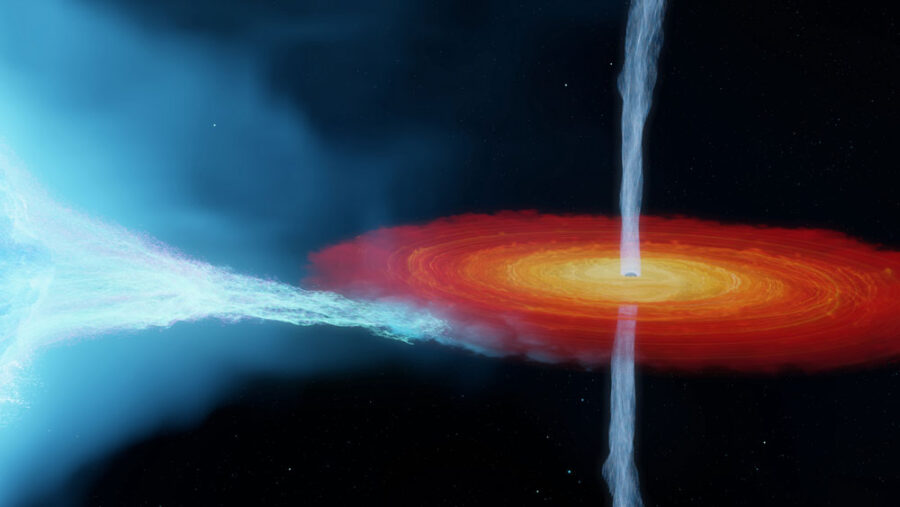New observations show that Cygnus X-1, the first black hole to be discovered, is more massive than originally thought — a finding that could challenge ideas about the evolution of massive stars.

International Centre for Radio Astronomy Research
New observations show that the first black hole to be discovered is more massive than originally thought. The study, which challenges ideas about the evolution of massive stars, appears today in Science.
The Mass of Cygnus X-1
Cygnus X-1 is part of a binary system, first discovered in 1964 by its powerful X-rays. Closer inspection showed a supergiant star orbiting an unseen companion every 5.6 days. The black hole is siphoning material away from the star, releasing X-rays and radio jets in the process.
About a decade ago, scientists were able to make the first precise calculations of the system’s distance and mass using the Very Long Baseline Array (VLBA), a network of radio telescopes spread across the U.S.
“As the Earth moves around the Sun, we see Cygnus X-1 from different vantage points,” explains study lead James Miller-Jones (International Centre for Radio Astronomy Research-Curtin University, Australia). As a result, Cygnus X-1 — and the radio jet it emits — appears to move back and forth against the backdrop of far more distant galaxies. Measuring this shift enables scientists to work out the distance to the black hole and its star companion, which affects the calculation of their masses. The 2011 observations were taken over the course of a year and suggested that Cygnus X-1 is about 6,000 light-years away and 15 times the mass of the Sun.
For the current study, Miller-Jones and colleagues used the VLBA to observe the system over six days to watch how the radio emission changes over the course of a single orbit. They used this information to correct for the supergiant’s stellar wind, which absorb radio emission passing through it and can thus shift the apparent position of the black hole’s radio jet base. Combining this understanding with archival observations taken over more than seven years, the team obtained improved radio measurements.
The new results show that Cygnus X-1 is more than 7,000 light-years away and thus more massive than originally thought. The new calculations show the black hole has the mass of 21 Suns; the giant star companion is around 40 solar masses. The results put the radio measurements in agreement with visible-light measurements of parallax from the European Space Agency’s Gaia satellite.
The Origin of Cygnus X-1
These findings provide insight into the system’s history. The black hole likely formed from a star that started with between 55 and 75 times the Sun’s mass but lost more than half that via stellar winds by the end of its fusion-powered life. Even then, star was massive enough to have collapsed into itself without going supernova. Miller-Jones and colleagues estimate that the star lost only about a solar mass during the collapse. The black hole’s fast spin, the system’s alignment, and its steady pace through space also support Cygnus X-1’s supernova-less end.
The LIGO and Virgo gravitational-wave detectors have found surprisingly massive systems — but they’re far away and therefore formed when the universe was younger. With fewer heavy elements around, the stars in these systems would have produced weaker winds, making it easier to maintain their heft when they collapsed into black holes. Nearby black holes detected via the light the systems emit, on the other hand, have been found to be less substantial, with even the heftiest of them containing only 15 Suns’ worth of mass.
On the contrary, massive Cygnus X-1 formed in an environment rich in heavy elements. To explain how the star that preceded the black hole held onto so much of its bulk, Miller-Jones thinks it must have not lost much mass via stellar winds. “This requires us to recalibrate our theoretical models of how massive stars lose mass in winds,” he adds, “and it allows for the formation of more massive black holes.”
Adam Ingram (University of Oxford), who was not involved in this study, says the results are significant. “The new distance measurement looks really solid, especially since it agrees with the existing measurement by Gaia,” he says. A higher mass for Cygnus X-1 suggests that “the progenitor stars that end up forming merging black hole systems can have a higher metallicity than was previously thought, and therefore could have formed later.”
Elena Gallo (University of Michigan), who was not involved in this study, is also excited about the result. She thinks it might mean that black hole formation could be independent of the heavy-element content of the environment in which it formed. If that’s true, then maybe massive stellar-mass black holes didn’t only form in the early universe; they might also be able to form nearby.
 0
0









Comments
You must be logged in to post a comment.